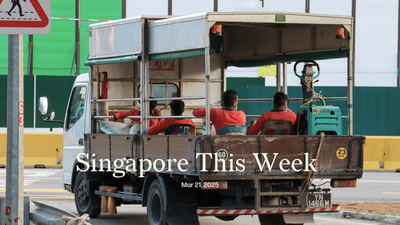Society: Multiculturalism beyond “the common space”
Tharman Shanmugaratnam, senior minister, said that in addition to its “system strengths”—public housing, healthcare and education—Singapore needs to develop the intrinsic capabilities of its people. This includes a depth of expertise and the ability to engage in civic discourse. Interestingly, in a lecture at the Singapore Management University, he also called for a multiculturalism that looks beyond the private space and “the common space”. The common space framework has long reflected the ruling People’s Action Party’s fear that cultural differences can easily tip over into ethnic tensions. Within the common space, expressions of diversity—such as the wearing of the tudung—are meant to be muted. “I believe we can develop this third space—keep the emotional assurance of our own cultures, and the common space which we protect very carefully, but let's develop that rich Singapore identity and go further.” To achieve this he urged Singaporeans to, among other things, develop a better understanding of the region and consider conversational Malay and Chinese. We agree. In this week’s Jom essay, “Headscarves and social fabrics”, we examine the genesis of Singapore’s tudung restrictions—and how the common space philosophy has crimped a more organic cross-cultural appreciation and pollination in society.
Society: A greener F1?
This week Singapore hosts “the most expensive travelling circus in sports”, as DW, a German publication, puts it. Ahead of that, the local organiser has announced a slew of green initiatives: clean energy supply to the pit building and grandstands; biofuel generators; a “hypercomposter” for food waste; and plans for solar panels for next year’s edition. Hurrah. These may assuage some consciences, but will do little to change the fundamentals of one of the world’s most pollutive sports, which involves flying vehicles, equipment and celebrities around the world. Wary of a growing backlash amid the climate emergency, Formula 1 (F1) in 2019 published figures about its environmental impact: 256,000 tonnes of CO2 emissions each season, the equivalent, DW found, to running 55,795 passenger vehicles for one year. Some 45 percent of that is from the air, sea and road transport logistics; and a further 27.7 percent from the transport of personnel, promoters and partners. F1 has committed to being net carbon zero by 2030, though a strategy of mitigation without serious reduction may eventually run out of gas. Many Singaporeans have long doubted the supposed economic benefits of hosting F1. Here’s one more reason to rethink it.
Science: Magnetic pull of alternative meats
Growing meat, like cell-cultured pork, in the lab has just gotten greener, with the use of magnetic pulses instead of animal products. Researchers at the National University of Singapore have observed that sending a magnetic field through animal cells releases molecules with regenerative, metabolic, anti-inflammatory and immunity-boosting properties. Published in the journal Biomaterials in August, the research shows that magnetic fields cause cells to multiply better and survive longer than when animal serum was added to them. FoodTech supports Singapore’s efforts to diversify its food sources and make its supply more sustainable. It plans to produce 30 percent of the nation’s nutritional needs by 2030—it currently imports 90 percent of its food. All this has increased investors’ appetite for alternative, or alt-, meat, which includes plant-based and cultivated meat (produced by cultivating animal cells directly). In 2020, Singapore was the first country to approve the sale of cultivated meat products. More homegrown Singapore start-ups sniffing lucrative business opportunities have sowed huge investments in this field. Think NextGen Food’s Tindle brand, Shiok Meats, ALTN, Su Xian Zi, and Karana’s whole-plant jackfruit replacement meats. This is good news for the planet and its animals, as more meat-eaters chew on the idea of switching to the safer diets of flexitarians—meat substitutes are less prone to the risk of contamination and food poisoning. Any freezing of chicken imports in the future will also become a lot easier to swallow.
Internet culture: Never be too facetious when discussing exploitation
A clip from Anthony Bourdain’s 2017 visit to Singapore has gone viral on Twitter. The video features Bourdain at dinner with locals, Jom’s editor-in-chief among them, while they talk about helpers being the “opiate of the masses”. Reactions online have been chiefly critical, taking aim at one woman’s flippant characterisation of employer-helper relations that are often exploitative. The post has made an international audience aware of Singapore’s reliance on foreign domestic labour, and has sparked a larger conversation about how these arrangements are often exploitative and even dehumanising.
Editor-in-chief’s note: I’m glad the issue of foreign domestic worker exploitation in Singapore is in the spotlight. Over dinner, we raised it to Bourdain, highlighting systemic issues, such as inequality and stratified wage structures, which lead to helper abuse and other forms of bigotry. Many Singaporeans are implicated. It would have been disingenuous to ignore our own privilege and dependency on help. Part of that involved some (unwise) attempts at self-deprecating parody, which the producers focused heavily on. I guess the caricatures make for better TV, more so when chopped up on Twitter.
Arts: A Journey by Lorry—art on the unsafe practice of transporting low-wage workers
The art exhibition, A Journey by Lorry, is a fine example of the importance of civilian-led advocacy for the rights of the marginalised in society—in this case, migrant workers. Even more powerful is the fact that it was co-organised by members of the community, advocating for their own rights. MD Sharif, a Bangladeshi who has worked in Singapore since 2008, noted that he and two others—fellow Bangladeshi Ripon Chowdhury and Singaporean Kethlyn Gayatiri—had received “negative feedback” and were “discouraged” from running the event. There were genuine concerns that being involved (and even visiting the exhibition) could threaten the livelihoods of the migrants, for instance not having their work permits renewed. (The recent injustice involving another Bangladeshi, Zakir Hossain, has added to this simmering fear.) The exhibition brings together artwork by tertiary students and evocative first-hand accounts by workers about being transported at the back of lorries. Their nagging anxiety about getting killed in an accident, as has happened to their peers, is palpable. “We have lost so many lives already. How many more should we lose before anyone does anything about it?” Sharif asked on Facebook. The exhibition is on at Projector X Riverside until October 9th, with music performances, poetry readings and panel discussions. Find out more here.
History weekly by Faris Joraimi
Late last month, Penang’s heritage community was outraged by the unlawful destruction of the large 138-year-old tomb of Lady Foo Teng Nyong, third wife of Kapitan Cina Chung Keng Wee. Chung was leader of the powerful Hai San Society, one of the two rival Chinese clans that battled for tin in Perak’s Larut Wars (1861-1874). Allied with the Malay lord Ngah Ibrahim, the Hai San fought against the Ghee Hin, who were backed by Raja Abdullah, then-heir to Perak’s throne. Chung and Abdullah were signatories of the Pangkor Treaty that ended the conflict and began British rule in Perak. Unfortunately, not much is known about Foo except that, as indicated on the tomb, she was born in 1849 and died in childbirth at 34 in 1883. It was built in the Cantonese throne-shaped style that originated in southern China, and became common across the Malay world. But Foo’s tomb–with its exquisite carvings and Straits-European elements–is considered unusually grand, a sign not only of its patron Chung Keng Wee’s wealth, but also perhaps of his love for Foo (locals dubbed it “Penang’s Taj Mahal”). In February, the landowners notified Foo’s descendants of the grave’s impending exhumation in a local newspaper. They had redevelopment plans. Appeals and petitions were organised to save the landmark; Penang’s Heritage Commissioner even promised to preserve it. But on August 28th, the tomb was dismantled without official permission and chucked in a landfill. This tragic outcome holds lessons for Singapore, with our own share of historically-significant gravesites. We may only rarely suffer similar administrative negligence, but we have lost much to our habit of putting “development” above everything.
Tech: Tech conferences give Singapore’s F&B and MICE industries a shot in the arm
Over the last two weeks, Singapore hosted numerous tech conferences. At Tech in Asia, regional bigwigs—including Tess Wijaya, co-founder of Xendit, an Indonesian payment gateway; Pratik Gandhi, co-founder of NIUM, which facilitates digital cross-border money transfers; and Anna Irmina "Minette" B. Navarrete, president of Kickstart Ventures—spoke about the ongoing start-up investment winter, the future of ClimateTech in South-east Asia, and the road to an IPO. SuperReturn Asia—a key private equity and venture capital conference—attracted a record 1,500 people, almost double the pre-pandemic record. Why are all these conferences happening now? Besides finding ways to invest their monies, financiers and founders are likely here to catch the adrenaline-packed F1 weekend. The Singapore Tourism Board expects nearly 90,000 delegates to attend about 25 MICE events coinciding with the race. F&B owners will likely squeal with joy given that more than 190 networking events are being hosted on the sideline of the Token2049 conference. Given the boost to its battered F&B and MICE industries, the Singapore government might just bite its tongue on any criticism towards cryptocurrency this week.
Tech: Grab announces at first investor day that it won't layoff employees
Amidst the current wave of layoffs happening in tech companies, such as Shopee and Foodpanda, Grab said it will not be laying off staff and will continue hiring, albeit more selectively. The South-east Asian ride-hailing and food delivery giant aims to break even on a group-adjusted EBITDA basis by the second half of 2024. Some of the measures to cut costs include shutting distribution hubs for on-demand groceries and slowing down the operations of its cloud kitchen facilities. It is also limiting its push into financial services, having reorganised its fintech unit to focus on more lucrative areas. Grab also reduced tens of millions of dollars in potential third-party mapping fees every year, by launching its own map tech and location-based intelligence tools. Despite all this, Grab’s share price has plunged 12 percent since the announcement of its Q2 results. Nonetheless, Grab employees can heave a sigh of relief.
If you enjoy Jom’s work, do get a paid subscription today to support independent journalism in Singapore.








